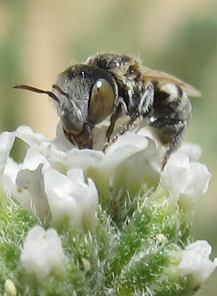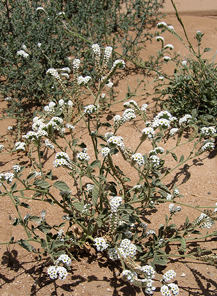Genus Haetosmia
Female of Haetosmia circumventa collecting pollen on a flower of Heliotropium (left); Heliotropium (Boraginaceae) is the exclusive pollen source of the Haetosmia species (right). Fotos Claudio Sedivy and FlowersInIsrael.com.
Biogeography and diversity
The genus Haetosmia occurs in the Palaearctic and Afrotropical region (Müller & Griswold, 2017). It contains 6 described species, 5 of which occur in the Palaearctic.
Phylogeny and classification
Haetosmia is a member of the Osmia group (Praz et al., 2008b). Most phylogenetic analyses placed it as the basal branch within the Osmia group (Praz et al., 2008b; Sedivy et al., 2013c), although in some analyses it was sister to a large clade consisting of Wainia, Osmia, Atoposmia and Ashmeadiella (Praz et al., 2008b).
Nesting biology
As all Haetosmia species seem to be restricted to sandy ground (Mavromoustakis, 1954b for Haetosmia vechti; A. Müller and C. Sedivy, personal observation for H. circumventa; C. Praz, personal observation for H. brachyura) and the females possess long bristles on tibia and tarsus of their forelegs, which might be an adaptation to flip away sand during nest excavation, species of Haetosmia were supposed to nest in the soil. Indeed, H. vechti was recently found in Israel to nest in excavated burrows in sandy soil (Gotlieb et al., 2014). Its nests were found to consist of an excavated burrow ending in a small chamber, which contains a small cluster of urn-shaped cells built from masticated leaves partly mixed with small pebbles and sand grains.
Flower preferences
All species exploit flowers of Heliotropium (Boraginaceae) as most probably exclusive pollen source. The females have long, apically curved and capitate bristles on the second segment of their labial palpi (Peters, 1974). As already assumed by Peters (1974), these modified bristles serve to extract pollen from the tiny and narrow-tubed Heliotropium flowers (Gotlieb et al., 2014).
Species accounts
Haetosmia altera (Peters, 1974)
1974 Osmia (Haetosmia) brachyura altera Peters, Senckenbergiana Biologica (Frankfurt), 55: 294. Combination Haetosmia altera in Müller & Griswold (2017). Type material: Holotype f, “Gulbahar, 1700 m” [Afghanistan], SMFD (Frankfurt); paratypes mm, ff.
Distribution-Southwestern Asia: AFG, IR, PAK. Northern Asia: TM, UZ.
Identification-Keys, Descriptions: Peters (1974); Müller & Griswold (2017).
Nesting biology: Unknown.
Flower preferences: Probably narrowly oligolectic on Heliotropium (Boraginaceae) (Müller & Griswold, 2017).
Haetosmia brachyura (Morawitz, 1875)
1875 Osmia brachyura Morawitz, Travel to Turkestan by A. P. Fedtschenko, p. 97. Type material: m(m), “in deserto Kisilkum” [Turkestan].-Combination Anthocopa (Haetosmia) brachyura (Morawitz) in Zanden (1988b: 119).
1875 Osmia latipes Morawitz, Travel to Turkestan by A. P. Fedtschenko, p. 97. Type material: f(f), “in deserto Kisilkum” [Turkestan]. Type species of Haetosmia Popov.-Combination Anthocopa (Haetosmia) latipes (Morawitz) in Popov (1952b: 103).-Synonymy in Peters (1974: 293).
Distribution-Northern Asia: TM, UZ; Turkestan.
Identification-Keys, Descriptions: Ducke (1900); Peters (1974); Popov (1952b: 103); Müller & Griswold (2017).
Nesting biology: Unknown.
Flower preferences: Most probably narrowly oligolectic on Heliotropium (Boraginaceae) (Gotlieb et al., 2014). Additional flower records: Salsola richteri (Popov, 1960b).
Haetosmia circumventa (Peters, 1974)
1974 Osmia (Haetosmia) circumventa Peters, Senckenbergiana Biologica (Frankfurt), 55: 297. Type material: Holotype m, “Gran Canaria, Maspalomas, Dünen” [Canary Islands], SMFD (Frankfurt); paratypes mm, ff.-Combination Anthocopa (Haetosmia) circumventa (Peters) in Zanden (1988b: 119).
Distribution-Northern Africa: E(Ca), ET, LAR, MA. Southwestern Asia: IL, OM, SA, UAE. Extralimital: Afrotropic (Mauritania, Niger, Sudan).
Identification-Keys, Descriptions: Peters (1974, 1975: 54-55); Müller & Griswold (2017).
Nesting biology: Unknown.
Flower preferences: Narrowly oligolectic on Heliotropium (Boraginaceae) (Hohmann et al., 1993; Gotlieb et al., 2014). Additional flower records: Neurada procumbens (Peters, 1974).
Haetosmia pakistaniensis Müller & Griswold, 2017
2017 Haetosmia pakistaniensis Müller & Griswold, Zootaxa, 4358: 359. Type material: Holotype f, “Baluchistan province, Pishin” [Pakistan], Smithsonian Instiution; paratypes m, f.
Distribution-Southwestern Asia: PAK.
Identification-Keys, Descriptions: No supplementary or more detailed morphological description known.
Nesting biology: Unknown.
Flower preferences: Probably narrowly oligolectic on Heliotropium (Boraginaceae) (Müller & Griswold, 2017).
Haetosmia vechti (Peters, 1974)
1974 Osmia (Haetosmia) vechti Peters, Senckenbergiana Biologica (Frankfurt), 55: 294. Type material: Holotype m, “Teheran-Evin, Institutsgelände” [Iran], SMFD (Frankfurt); paratypes mm, ff.-Combination Anthocopa (Haetosmia) vechti (Peters) in Zanden (1988b: 119).
Distribution-Europe: GR?. Southwestern Asia: IL, IR, JOR, TR. Northern Asia: TM.
Identification-Keys, Descriptions: Mavromoustakis (1954b: 267-268, as Osmia latipes var.); Peters (1974); Müller & Griswold (2017).
Nesting biology-Nesting site: Excavated burrows in sandy soil. Nests consist of a single burrow, which descends diagonally from the entrance to a single enlarged brood chamber situated 5-15cm below ground surface. This chamber contains 2-6 more or less vertical, urn-shaped and about 8mm long brood cells, which are positioned side by side and adhered to one another with their rear ends being embedded in soil and their tops being exposed. Nesting material: The cells are built with masticated leaf pulp of Centaurea procurrens and Heliotropium suaveolens and are covered with pebbles and sand grains. (Gotlieb et al., 2014)
Flower preferences: Narrowly oligolectic on Heliotropium (Boraginaceae) (Mavromoustakis 1954b; Gotlieb et al., 2014). Additional flower record: Gymnocarpos decander (Gotlieb et al., 2014).

